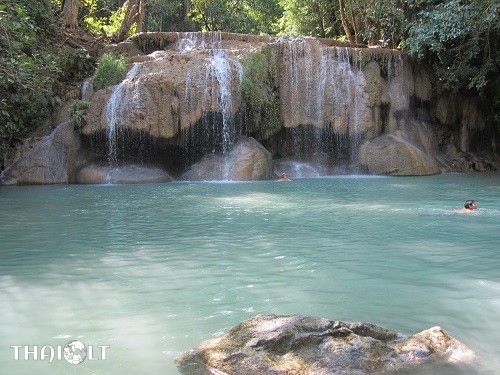Kanchanaburi is a city in Central Thailand and the capital of Kanchanaburi Province, located at the confluence of the Kwai Noi and Kwai Yai rivers. Kanchanaburi is not only interesting place to visit by itself but is also used as a base for exploring cultural, natural, and historical attractions found in the surrounding area.
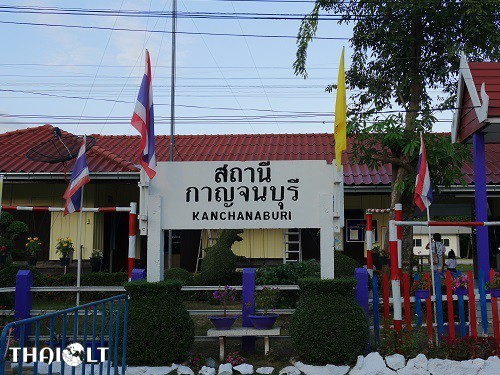
Kanchanaburi was originally established by King Rama I as the first line of defence against the Burmese as the province is bordering with Myanmar, but the WWII history of the city is the main reason why it is famous now. In Kanchanaburi you can find a number of memorials dedicated to WWII and the infamous Death Railway. You can also get to know how the WWII prisoners of war suffered there. The city is the home of the famous Bridge on the River Kwai.
Kanchanaburi is an excellent tourist destination for nature lovers. The city itself is a place to relax on the banks of the River Kwai, inside a raft house or riverside restaurant. The surrounding countryside has many natural attractions to explore. You can visit several spectacular waterfalls, mountains, caves, forests and three of Thailand’s largest reservoirs.
Attractions in Kanchanaburi
Kanchanaburi and the surrounding area features the famous Bridge on the River Kwai, the Death Railway, 3 war museums, 2 war cemeteries, a national museum, a historical park, national parks with waterfalls, mountains, caves, hot springs, and few nice Thai and Chinese temples dispersed in the countryside.
Bridge On the River Kwai
The Bridge over the River Kwai for most visitors is the main sight of interest in Kanchanaburi. The bridge is the start of the infamous World War II Death Railway to Burma (now Myanmar) and was erected through the forced labour of British, Dutch, and American prisoners of war during WWII. The bridge is still in use today and you can ride across the bridge taking a daily on the historical route from Kanchanaburi to Nam Tok Railway Station.
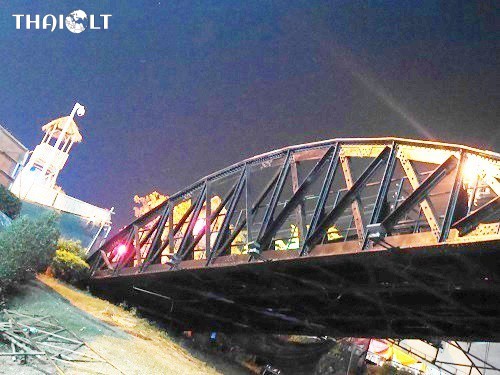
Death Railway
The infamous Death Railway to Burma was constructed by prisoners of war working for the Japanese during WWII. This 415 km long railway was intended to move men and supplies to the neighbouring Burma where the imperial Japanese army was fighting the British. The Death Railway is named so because of the numbers of men who died during construction. Some 16,000 prisoners of war (most of them were Australians, Dutch and British) and 90,000 Asian workers (most of them enslaved) died during railway construction.
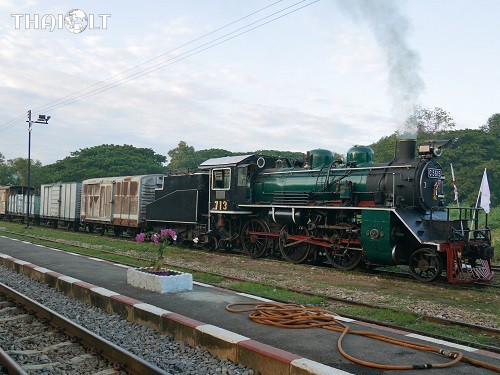
Kanchanaburi War Cemetery (Don Rak)
Kanchanaburi War Cemetery is also known as Don Rak War Cemetery. The cemetery is located on Sangchuto Rd, across from the Kanchanaburi Railway Station.
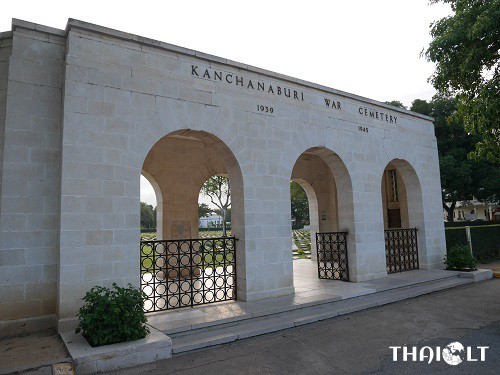
Kanchanaburi War Cemetery contains the remains of nearly 7,000 British, Dutch, and Australian war prisoners who lost their lives during the construction of the Death Railway.
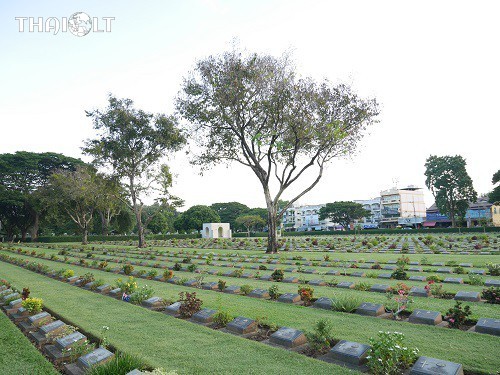
Other historical attractions around Kanchanaburi
Hellfire Pass & Memorial Museum – a 500 m long rock that was dug out by hand by prisoners of war to make the way for the Death Railway and a memorial museum honouring 700 of men who died during that time.
JEATH War Museum – museum designed as a replica of a prisoner of war camp.
Chonk Kai War Cemetery – cemetery housing the graves of 1740 prisoners of war.
War Museum at the Bridge – museum displaying collection of World War II instruments, photographs and uniforms, as well as expositions related to ancient battles between Thailand and Burma (Myanmar), Thai political history, and old Khmer-style woodcarvings.
Thai-Burmese Railway Centre - an interactive museum dedicated to the history of the Thailand-Burma Railway.
Erawan National Park
Located near Kanchanaburi, Erawan National Park is a large protected nature reserve best known for its beautiful seven tiered Erawan waterfall, considered to be among the most beautiful waterfalls in Thailand. You can take a scenic 2 kilometer trek through the forest and climb up the seven levels to the top of the falls while stopping to refresh in the pools on your way.
Erawan National Park from Kanchanaburi can be reached by taking a local bus. More about it: Bus Kanchanaburi - Erawan.
Where to Stay in Kanchanaburi
The best place to stay in Kanchanaburi is near the River Kwai. For places to stay in Kanchanaburi check Hotels in Kanchanaburi on Booking.com or Hotels in Kanchanaburi on Agoda.com.
How to get to Kanchanaburi?
Kanchanaburi is located in Central Thailand not far from Bangkok and can be easily accessed from there by bus or by train.
Bus to Kanchanaburi
Buses to Kanchanaburi leave Bangkok Southern (Sai Tai Mai) Bus Terminal every 15 minutes and it takes about 2 or 3 hours to get there, depending on the class of a bus and the traffic. There are also buses leaving from Bangkok Northern Bus Terminal (Mo Chit) but they run less frequently.
Minivans to Kanchanaburi are also available at these Bangkok’s bus stations (at Northern Bus Terminal minivans leave from a separate Mochit Van Terminal) as well as Khao San Road. Various transportation options can be found by using this search form.
Kanchaburi can be easily reached by buses from other nearby cities such as Nakhon Pathom and Sangkhlaburi. If you are staying in Hua Hin, you can also get a minivan going from Hua Hin to Kanchanaburi.
Train to Kanchanaburi
Trains leave Bangkok's Thonburi Train Station and arrive at Kanchanaburi in about 3 hours. There are only 2 daily trains going to Kanchanaburi so you should plan accordingly.
Flight to Kanchanaburi
The nearest airport is in Bangkok.
Private Tour
You can book a private tour for more comfortable visit to Erawan National Park and other Kanchanaburi attractions. Private 2 day tour from Bangkok can be booked online here: Kanchanaburi 2-Day Private Tour From Bangkok.
Weather in Kanchanaburi
In Kanchanaburi the seasons are clearly defined. Between November and May the weather is mostly dry with little rain expected throughout the region for much of this time. The dry season in Kanchanaburi is broken up into the periods of cool season (November to February) and hot season (March to May), when it is not unusual for the temperature in Kanchanaburi to reach even 40°C.
The wet season in Kanchanaburi is from May to November. The rain usually comes in the form of short showers, lasting an hour or two. As the rainy season progresses, the rain can become heavier and more constant, traditionally reaching peak levels in August and September.
For the best time to visit Kanchanaburi check our Central Thailand weather ratings chart.
| Jan | Feb | Mar | Apr | May | Jun | Jul | Aug | Sep | Oct | Nov | Dec |
|---|---|---|---|---|---|---|---|---|---|---|---|
| ★★★★☆ | ★★★★☆ | ★★★☆☆ | ★★☆☆☆ | ★★☆☆☆ | ★★★☆☆ | ★★★☆☆ | ★★★☆☆ | ★★★☆☆ | ★★★☆☆ | ★★★★☆ | ★★★★★ |
After visiting Kanchanaburi you are planning to continue your trip up north or down south? Check when is the best time to visit Thailand's other destinations and choose your next destination.

